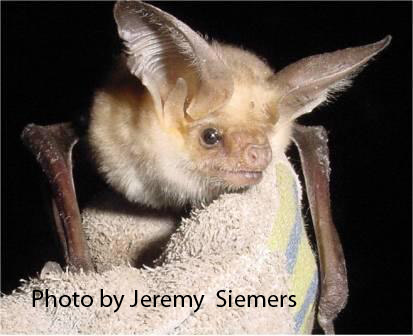Bats of Colorado > Pallid bat (Antrozous pallidus)


The pallid bat is a large, pale, rather long-eared bat, not easily confused with any other species. Their eyes are large, and their face is covered with wart-like sebaceous glands. Color varies from pale creamy to light brown. Average measurements of 12 individuals from northwestern Colorado were: total length, 107 mm; forearm, 56 mm; and weight, 19 g. Wingspan is approximately 380 mm.
The range of the pallid bat extends from southern British Columbia to central Mexico and east to central Kansas and Oklahoma. In Colorado this bat inhabits lower elevations of the Western Slope, broken rocky areas of the southeastern part of the state and along the foothills to Colorado Springs. A report of an isolated colony at Torrington, on the plains of eastern Wyoming, suggests that the pallid bat could be found in rocky habitats pallid bat by Jeremy Siemersor structures on the plains of eastern Colorado.
This is a species of deserts and grasslands near rocky outcrops. The pallid bat's habit of using structures built by humans may allow it to extend beyond what would otherwise be its natural range. In Colorado, the pallid bat occupies semidesert scrub and piñon-juniper woodlands to about 7,000 feet. Pallid bats are gregarious, although males may separate from breeding females in summer. Elsewhere, this species is not migratory and makes only short movements to hibernation sites. Pallid bats probably hibernate in Colorado from mid-October to April, although there is no direct evidence of their winter habits here. Pallid bats form small colonies and may use rock crevices as day roosts. These roosts are selected for suitable temperature and protection from predators. Night roosts are also selected on the basis of a temperature that minimizes energy loss. Night roosts, such as crevices, shallow caves, overhangs, and man-made structures, are usually near day roosts. Both day and night roosts change seasonally as their thermal characteristics change. Mortality is highest when young bats pallid bat by Dan Neubaumare first beginning to fly. Their habit of foraging on the ground makes pallid bats susceptible to injury and predation. Predators include hawks, kestrels, owls and snakes.
Copulation occurs between October and December, and sperm are stored by the females until spring, when ovulation, fertilization and implantation happen. Gestation is about 9 weeks. Older females generally give birth to two young, whereas younger females have only one. Young are born in June and July, and the sex ratio of the newborn is 1 to 1. Young begin to fly between 28 and 35 days old and are completely weaned at 6 to 8 weeks. Mothers forage with the young until the young become independent.
The pallid bat feeds principally on flightless ground-dwelling arthropods, such as crickets, grasshoppers, beetles, scorpions and spiders. Their presence is revealed by audible clicks as they forage after full dark and again before sunrise. Other foods include large moths, lizards, small bats and small rodents.
Social behavior of pallid bats is quite interesting. There is a strong bond between mother and offspring, and the association may continue year after year. There is also strong group cohesion and roost site attachment. Young are provided preferential positions in roosts, pregnant females are attentive to other females in labor and females actually signal mothers whose young are in distress.
None





